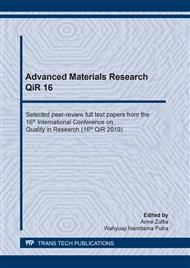p.285
p.293
p.303
p.311
p.318
p.324
p.331
p.339
p.348
Numerical Simulation of Carbon Dioxide Absorption by Monoethanolamine Solution with Super Mini Ring Contactor
Abstract:
Carbon capture storage provides an alternative to reducing global warming. In order to reduce the cost of carbon capture storage, high mass transfer packings for CO2 absorption from flue gas is an alternative. The study modeled and numerically simulated CO2 absorption by monoethanolamine solution with super mini ring contactor. The model considered the effect of the mass and momentum transfers, as well the chemical reaction. The simulation results show that the driving force of the reactive absorption is higher than the ordinary absorption in term of the low concentration of CO2 in the liquid phase. The CO2 concentration in the bulk gas is approximately 7.56 mol/m3. It decreases to around 5.75 mol/m3 after crossing the concentration boundary layer.
Info:
Periodical:
Pages:
318-323
Citation:
Online since:
July 2020
Authors:
Price:
Сopyright:
© 2020 Trans Tech Publications Ltd. All Rights Reserved
Share:
Citation:


